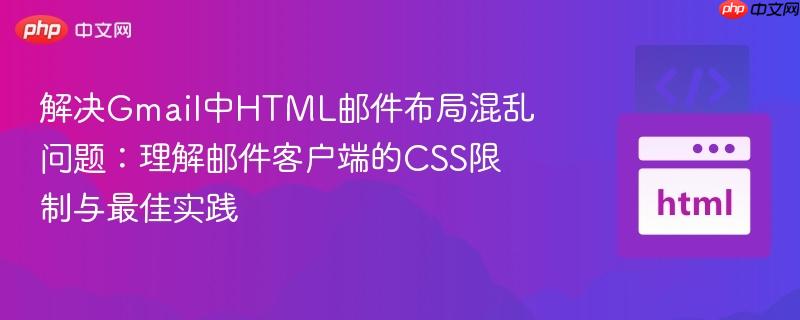
许多开发者在创建html邮件时,会发现邮件在网页浏览器或在线测试工具中显示完美,但在gmail、outlook等实际邮件客户端中却面目全非。这背后的根本原因在于邮件客户端的渲染引擎与现代web浏览器(如chrome、firefox)存在巨大差异。邮件客户端通常采用更老旧、更严格或功能受限的渲染引擎,它们对css的支持远不如现代浏览器。
具体来说,邮件客户端对CSS的支持更像是HTML 4时代的标准,这意味着:
根据上述邮件客户端的渲染特性,原始邮件代码中出现布局混乱的原因显而易见:
鉴于邮件客户端的渲染限制,构建HTML邮件的最佳实践是回归传统,采用基于 <table> 元素的布局。表格布局虽然在现代Web开发中已不常用,但其在邮件客户端中具有无与伦比的兼容性和稳定性。
将邮件内容视为一系列嵌套的表格。外部表格用于设置邮件的整体宽度、背景色,内部表格则用于划分不同的内容区域(如头部、两列布局、底部等)。
立即学习“前端免费学习笔记(深入)”;
示例代码:一个基本的响应式两列邮件布局
<!DOCTYPE html>
<html>
<head>
<meta charset="UTF-8">
<meta name="viewport" content="width=device-width, initial-scale=1.0">
<title>兼容性HTML邮件示例</title>
<style type="text/css">
/* 重置默认样式 */
body { margin: 0; padding: 0; -webkit-text-size-adjust: 100%; -ms-text-size-adjust: 100%; }
table { border-spacing: 0; mso-table-lspace: 0pt; mso-table-rspace: 0pt; } /* 消除表格间距,兼容Outlook */
td { padding: 0; }
img { border: 0; line-height: 100%; outline: none; text-decoration: none; -ms-interpolation-mode: bicubic; }
a img { border: 0; }
/* 响应式样式:在小屏幕上将两列变为一列 */
@media screen and (max-width: 600px) {
.outer-table {
width: 100% !important;
}
.inner-column {
width: 100% !important;
display: block !important; /* 关键:使列堆叠 */
padding: 10px !important;
box-sizing: border-box !important; /* 确保内边距不影响宽度 */
}
.full-width-image img {
width: 100% !important;
height: auto !important;
}
}
</style>
</head>
<body style="margin:0; padding:0; background-color:#f0f0f0;">
<!-- 整体容器,用于居中和设置背景色 -->
<center style="width:100%; table-layout:fixed; background-color:#f0f0f0;">
<!-- 最大宽度限制,兼容旧版Outlook -->
<!--[if (gte mso 9)|(IE)]>
<table width="600" align="center" cellpadding="0" cellspacing="0" border="0" style="width:600px;">
<tr>
<td>
<![endif]-->
<!-- 主内容表格 -->
<table class="outer-table" align="center" cellpadding="0" cellspacing="0" border="0" style="width:100%; max-width:600px; background-color:#ffffff;">
<tr>
<td style="padding:20px;">
<!-- 头部区域 -->
<table width="100%" cellpadding="0" cellspacing="0" border="0">
<tr>
<td style="font-family: Arial, sans-serif; font-size:24px; color:#333333; text-align:center; padding-bottom:20px;">
邮件标题
</td>
</tr>
</table>
<!-- 两列布局区域 -->
<table width="100%" cellpadding="0" cellspacing="0" border="0">
<tr>
<!-- 左侧列 -->
<td class="inner-column" style="width:50%; vertical-align:top; padding-right:10px;">
<table width="100%" cellpadding="0" cellspacing="0" border="0">
<tr>
<td style="font-family: Arial, sans-serif; font-size:14px; line-height:20px; color:#555555;">
<h3>左侧内容标题</h3>
<p>这是左侧栏的详细内容。我们使用嵌套表格来构建布局,确保在各种邮件客户端中的兼容性。</p>
<p>避免使用Flexbox、Grid等现代CSS布局,因为它们在大多数邮件客户端中不被支持。</p>
</td>
</tr>
</table>
</td>
<!-- 右侧列 -->
<td class="inner-column" style="width:50%; vertical-align:top; padding-left:10px;">
<table width="100%" cellpadding="0" cellspacing="0" border="0">
<tr>
<td style="font-family: Arial, sans-serif; font-size:14px; line-height:20px; color:#555555;">
<h3>右侧内容标题</h3>
<p>右侧栏的内容。即使是响应式设计,也应尽可能地依赖表格结构和有限的媒体查询。</p>
<p>像Cerberus这样的模板提供了经过验证的邮件设计模式。</p>
</td>
</tr>
</table>
</td>
</tr>
</table>
<!-- 底部区域 -->
<table width="100%" cellpadding="0" cellspacing="0" border="0">
<tr>
<td style="font-family: Arial, sans-serif; font-size:12px; color:#999999; text-align:center; padding-top:30px;">
© 2023 您的公司. 保留所有权利.
</td>
</tr>
</table>
</td>
</tr>
</table>
<!--[if (gte mso 9)|(IE)]>
</td>
</tr>
</table>
<![endif]-->
</center>
</body>
</html>在上述示例中,我们使用 <table> 元素来构建整体结构和两列布局。为了实现响应式,我们利用媒体查询在小屏幕上将 <td> 元素设置为 display: block 并占据 100% 宽度,从而实现列的堆叠效果。这种方法比依赖 flex 或 grid 更为健壮。
以上就是解决Gmail中HTML邮件布局混乱问题:理解邮件客户端的CSS限制与最佳实践的详细内容,更多请关注php中文网其它相关文章!

HTML怎么学习?HTML怎么入门?HTML在哪学?HTML怎么学才快?不用担心,这里为大家提供了HTML速学教程(入门课程),有需要的小伙伴保存下载就能学习啦!

Copyright 2014-2025 https://www.php.cn/ All Rights Reserved | php.cn | 湘ICP备2023035733号